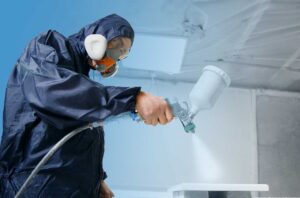November is Lung Cancer Awareness Month. Lung Cancer Awareness Month is about raising awareness about lung cancer, including how to recognise it, prevent it, and treat it.
Certain work environments can expose workers to substances and conditions that increase the risk of developing lung cancer. An estimated 12,000 people die from work-related lung diseases every year, highlighting the importance that occupational health plays in preventing lung cancer.
Key Workplace Causes of Lung Cancer
Asbestos fibres, once inhaled, can cause serious lung diseases, including asbestosis, mesothelioma, and asbestos-related lung cancer. Asbestos was widely used in construction before 2000, so any building from this era may contain asbestos, posing potential risks to workers.
Silica is a substance naturally found in rocks, sand, and clay, which are used to manufacture a wide variety of products. Different substances contain different levels of silica. Similar to asbestos, when substances are broken through tasks such as cutting, drilling, grinding, and polishing, silica dust can enter the lungs and cause lung-related diseases. Those in the construction industry are particularly vulnerable to silica dust.
The naturally occurring radioactive gas Radon is also a cause of lung cancer. Radon accumulates in confined spaces and, when breathed in, can change cells, causing cancer. Workers in basements, poorly ventilated areas, or underground settings are most susceptible to radon exposure.
Individuals exposed to diesel fumes created by diesel engines used in trucks, trains, and machinery for long periods can develop lung cancer. Additionally, those in the metalworking industry can be exposed to carcinogenic fumes from materials such as arsenic, cadmium, and chromium with the potential to cause lung cancer.
Preventing Lung Cancer in the Workplace
It is important that employers put into place steps to manage these risks, in particular in industries, such as construction, where there is an increased risk. Measures can include:
- Introducing training regarding causes of lung cancer in the workplace. This training should educate workers on the specific risks in their workplace environment, safe procedures, and how to identify the signs of occupational exposure.
- Having regular health screenings and occupational health checks for individuals with a high risk of being exposed to causes of lung cancer. This will allow signs of occupational cancer to be spotted early so action can be taken.
- Providing PPE for the job being undertaken when required. This includes ensuring appropriate respirators, masks, and protective clothing are used when needed.
- Providing proper ventilation and air filtration to reduce harmful particles in the air. In particular, filters can help capture toxic particles, minimising contamination in confined work areas.
The Health and Safety Executive (HSE) is currently running two campaigns to promote safer workplaces. The “Asbestos – Your Duty” and “Asbestos and You” campaigns provide guidance on managing asbestos in buildings and educate employees on staying safe from asbestos-related risks.
If you have any questions or would like support with managing issues at your workplace, please speak to your usual contact or get in touch using the form below.

HSE Launch Motor Vehicle Paint Spraying Campaign

Lifting Equipment and Pressure Systems: A Call For Evidence

Making PPE Fit As Standard

What To Do When It Isn’t Business As Usual

Taking Slurry Safety Seriously
